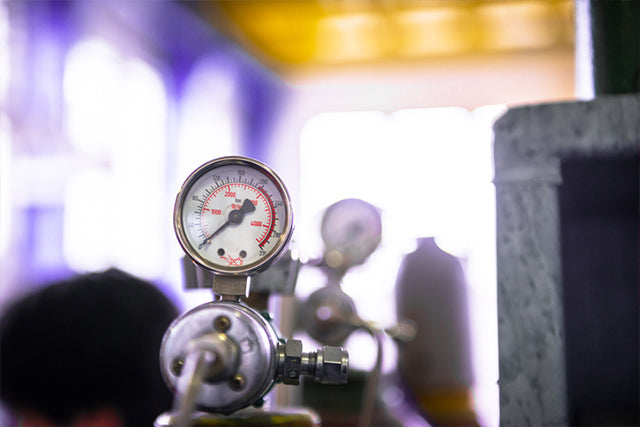No Products in the Cart
CFM
CFM is a measurement of AIR FLOW in Cubic Feet per Minute. Larger motors on compressors will produce more air – or higher CFM’s. Numerous tools operated at once or more technicians using air will increase the air demand on an air compressor. Processes that continuously use air – such as paint spraying – will use much more air than intermittent use of tools such as pneumatic wrenches. Depending on the task the compressed air is performing – either intermittent use or continuous use – different types of air compressors are recommended. A rotary type compressor is best for continuous duty cycles, while a reciprocating compressor is best for occasional use because it requires down time to cool off.
PSIG
PSIG is a measurement of PRESSURE in Pounds per Square Inch as read on a Gauge. Air compressors can generate and discharge air at several different pressures – such as 100, 125, 150, or 175 psig. What pressure is needed depends on the tool or process the air is used for. Air tanks or receivers are filled with compressed air, and store it for later use without putting a direct demand on the air compressor. As the air in the receiver is used the pressure lowers. When the pressure is low enough to reach it’s set point – the compressor will kick on and start compressing air again to raise pressure back up.

Horsepower
HP is a measurement of HORSEPOWER. The higher the horsepower, the more generating power of a compressor to maintain high flow rates of air. Higher horsepower will keep up with a systems air demands while in use, or charge air tanks or receivers at a faster rate. CFM can be estimated by Horse Power.
Reciprocating Air Compressors: (Horse Power) x (4) ≈ CFM
Rotary Air Compressors: (Horse Power) x (4) ≈ CFM
Tank Capacity
TANK CAPACITY is a measurement of AIR VOLUME in Gallons. Compressors can supply an air system, and store air in tanks or receivers. Compressors can be built together with air tanks or be independent of them. The bigger volume or larger gallon size of a tank means it can store more air. With more volume of air, higher flow rates or longer periods of discharge can be achieved when coming out of the tank.
Configurations of Equipment
CONFIGURATIONS of equipment can be BASE MOUNTED, TANK MOUNTED, HORIZONTAL, VERTICAL, and even PORTABLE. Depending on preference or application, there is a configuration to meet those needs. Base mounted units are ideal for large machines that supply large air loads, however, they require an air tank or receiver to store the air produced. Tank mounted units can be more compact, if floor space is important. Tank mounted units with built-in air dryers are even more compact, considering there is no extra piping or floor space needed for the dryer. Portable units can bring air to the job site, whether it be hand carried, wheeled, truck mounted, or towed.
Power
POWER to equipment is provided by either ELECTRICITY, GASOLINE, or DIESEL. The most common compressor applications use Electrical Power within a facility. Electrical Ratings include the following: Voltage, Phase, and Frequency.
Voltage can be either 115, 208, 230, or 460 Volts. Some equipment can even run off multiple voltage variations – for example: 115V and 230V. Other equipment can be rewired in the electrical hub to accept different voltages. This makes supplying power more convenient, and more versatile for facilities.
Phase can be either Single Phase or Three Phase.
Frequency is 60Hz for all of our equipment.
Gas or Diesel engines are typically found on portable compressors.

Someone purchased a
Thanks for your helpful article
This article helps me to select air compressor.When I buy something I always read read buying guide.This buying also assist me.
Dan,
We usually recommend a small portable electric reciprocating air compressor, sized 2HP to 5HP, but for sanding/grinding/paint spraying that may be too small to continuously supply air to those loads. I would recommend either a 4HP or 5HP stationary reciprocating air compressor, with a 60 or 80 gallon tank. Check out our CFM Calculator to determine what your air demand could be, and size your machine accordingly. If you undersize a reciprocating air compressor, it will run too long and not take breaks to cool. If you oversize an air compressor, it won’t hurt because it will charge the receiver and store plenty of air for your use. However, too big of a machine takes up space, and requires more energy to run.
Contact us with any questions! 904-548-6200 or email INFO@compressedairusa.com
Hi I just bought a house and it has a garage I was wondering what kind of compressor I would need for the application I would be using it for, I’d mainly be using it for air tools for mechanic and body work i.e impacts, sanders, paint guns and air brush any info/direction would be great thanks.